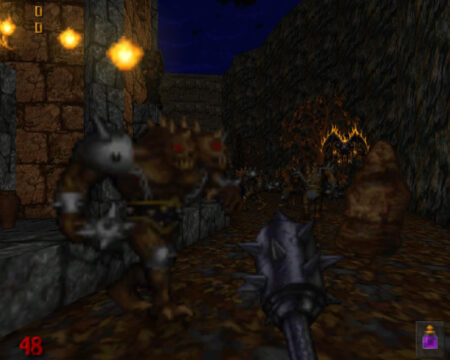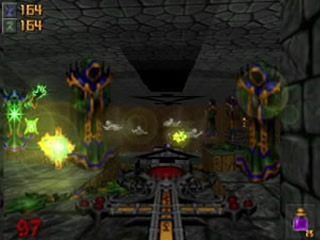
Hexen
Written by: Stoo
Date posted: September 2, 2003
- Genre: Action
- Developed by: Raven
- Published by: id Software
- Year released: 1995
- Our score: 7
What we have here is first-person title in a fantasy setting, based on the Doom engine. Regarding the plot… erm, basically the forces of Korax, a Serpent Rider (i.e. big evil overlord) are running rampant across the world. Only three heroes: a mage, a warrior and a cleric can try and stop these forces of darkness. That’s it, really…
Before Hexen, Raven brought us Heretic, which was the first game (if I recall correctly) by a third party to use the Doom engine. It has now passed into gaming legend as being “Doom in tights.” Basically, the transfer to a fantasy setting didn’t come off too well. The level designs weren’t great. The enemies just weren’t scary compared to those in Doom. The weapons, rather than having any kind of medieval feel, flung a range of brightly coloured projectiles and as such were just plasma guns in disguise. Plus your hero was a rather wimpy-looking elf. Heretic was by no means a terrible game, it just didn’t really succeed in its aims of producing a worthy fantasy cousin to iD’s epic milestone of a shooter. A year or two later then Raven had another go with Hexen, which I suppose it was intended as a kind of pseudo-sequel. However it might be better to say that Hexen is what Heretic should have been in the first place.
You start by choosing your hero, and each of these guys handles quite differently in the game. The fighter is the fastest and strongest, and has the highest basic armour rating with which to resist damage (which is a bit odd as he seems to run around in his pants). His weapons are generally suited to close-combat, with big glowing enchanted axes and swords being the order of the day. The Mage on the other hand is fairly wimpy, and uses ranged weaponry in the form of wands and spells to take down enemies from a safe distance. The cleric sits somewhere in between; having a cool mace to batter people around the head with, and also a few mid-ranged attacks. Each hero has only four weapons, which seems a little disappointing at first if you’re used to staggering around with eight guns under your jacket, as is the norm for first-person titles. However, the selection is well balanced, with each hero having an initial weapon that can be used freely without any kind of “ammo”, a couple of more powerful ones that are powered by mana (the traditional magical fuel or ammo in fantasy games) and a final awesome mana-gobbling weapon that must be assembled from several pieces.

Once you’ve chosen, it’s time to polish your gauntlets\adjust your chain mail\iron your girly mage’s robes (choose as applicable) and step forth to kick some arse. So how does it look? Well, the limitations of the Doom engine do still apply: For one thing, the villains are all sprites. Also, the levels are based on a 2D floor plan – for every location on the horizontal plane there can only be one ‘floor’ point. In other words no bridges or rooms above rooms. Still, given all these conditions, Raven did a sterling job of creating a convincing world for the game to take place in. There’s brooding stone towers, murky swamps, and ancient temples to run around in, and I still find myself occasionally pausing just to admire the scenery. It’s an improvement on the random halls and tunnels of Doom, anyway. Overall there’s a dark and gloomy feel to the game, and it’s quite atmospheric in places.
Raven did add a few extra touches to the engine. For instance the ability to jump made a belated appearance, after your annoying inability to scale three-foot walls in the previous Doom-powered games. Walls sections can move horizontally – something not possible in Doom – which apart from “crushing wall” traps also means practical features like sliding or swinging doors. There are lots of other dynamic features to keep you on your toes, like spikes rising through the floor, traps spewing fireballs, and chasms opening at your feet. Finally, there’s several extra nice little touches like leaves blowing in the wind, or windows shattering into tiny pieces.
As a final note on graphics, you can give the game a major upgrade in this department, thanks to the the Jhexen project. This is a Win32 port for the game, adding support for Direct 3D and OpenGL. Okay, it’s still not quite Unreal 2, but bumped up into hi-res and with and some nifty coloured lighting effects added, Hexen looks pretty cool. (The 2nd screenshot on this page was taken in Direct3D mode). So I’d just like to voice my thanks to the people behind projects like this, keeping the oldies alive.
(2025 comment: I’ve no idea which source port is most favoured these days)

Meanwhile, the game requires a little more in the way of coherent thought than the bloody hacking of your way to a “finish level” button. Rather than being in a linear series, the levels come in clusters. Each of these clusters have a common theme in design, and are based around “hub” levels that link to the rest of the cluster through multiple two-way teleporters. Often if you’re stuck on one particular level, you’ll find you need to flick a switch or use an item in another and this tends to lead to you spending a lot of time retracing your steps. At its worst, Hexen can thus become a case of wandering around searching for a switch, then doing another circuit of the levels trying to find out what that switch actually did. Still, it’s not always that bad, and the game does give you clues as to what effects your actions are having, with messages like “one third of the puzzle at the dark wood is solved” or “stairs have risen at the seven portals.”
Perhaps the biggest weakness in Hexen is that the token storyline does nothing to drive the game along, and as such is almost entirely irrelevant. The main evil guy is Korax the Serpent Rider, but he may was well be some bloke called Derek for all we the players care. Now, a strong story is not an essential feature in a game, but it can serve as a kind of extra backbone that helps props the whole thing up, and keeps us going if the gameplay begins to flag a little. Then again Hexen still does provide something a bit more involving than simple fragfests. Of course System Shock was even better, and Looking Glass had been creating “intelligent” first person games for as long as iD had been providing blastathons, but sadly not enough people were paying attention. So Raven do deserve some credit here, for making their own effort to move the genre on a little. Personally, I enjoyed this more than Duke Nukem or any of the Quakes.


 Posts
Posts
The Steam version is fully compatible with all source ports. The same applies to other DOOM engine games. I’ll give Hexen II a try and see if it’s compatible with any of Quake sourceports.
July 24, 2013 @ 1:29 am